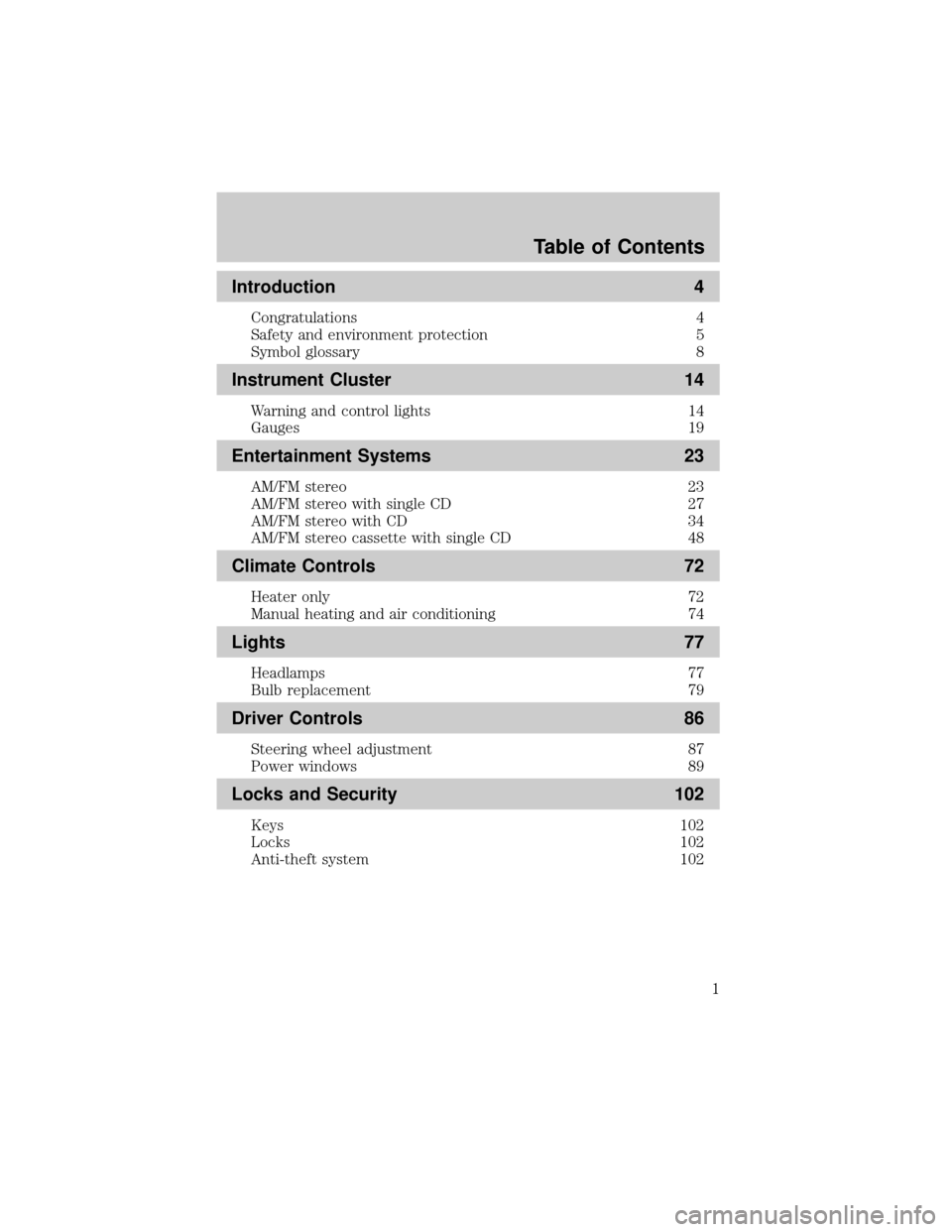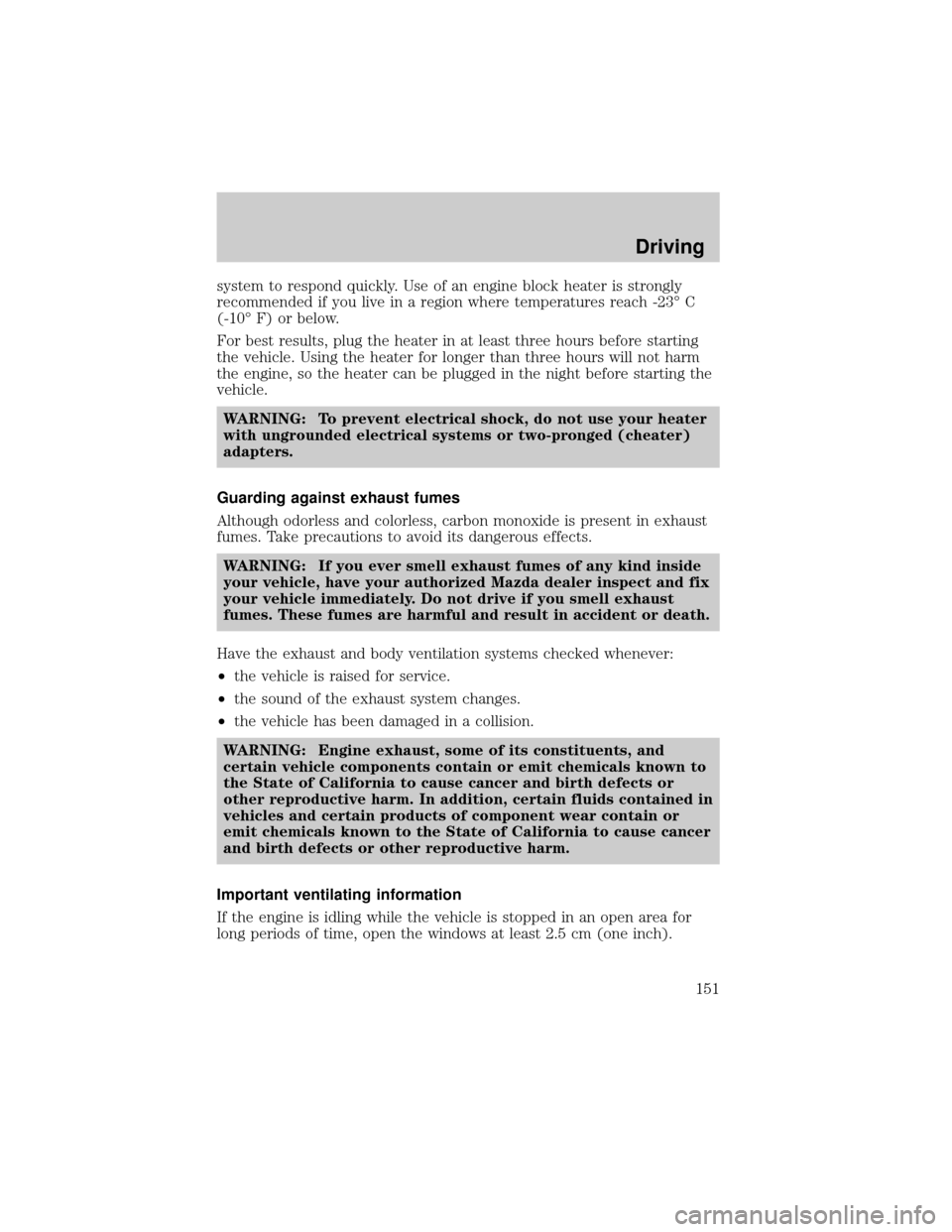heater MAZDA MODEL B-SERIES 2002 Owners Manual (in English)
[x] Cancel search | Manufacturer: MAZDA, Model Year: 2002, Model line: MODEL B-SERIES, Model: MAZDA MODEL B-SERIES 2002Pages: 287, PDF Size: 2.47 MB
Page 1 of 287

Introduction 4
Congratulations 4
Safety and environment protection 5
Symbol glossary 8
Instrument Cluster 14
Warning and control lights 14
Gauges 19
Entertainment Systems 23
AM/FM stereo 23
AM/FM stereo with single CD 27
AM/FM stereo with CD 34
AM/FM stereo cassette with single CD 48
Climate Controls 72
Heater only 72
Manual heating and air conditioning 74
Lights 77
Headlamps 77
Bulb replacement 79
Driver Controls 86
Steering wheel adjustment 87
Power windows 89
Locks and Security 102
Keys 102
Locks 102
Anti-theft system 102
Table of Contents
1
Page 72 of 287

HEATER ONLY SYSTEM
Fan speed control
Controls the volume of air circulated
in the vehicle.
Temperature control knob
Controls the temperature of the
airflow inside the vehicle. On
heater-only systems, the air cannot
be cooled below the outside
temperature.
Mode selector control
Controls the direction of the airflow
to the inside of the vehicle.
²
(Panel) ± Distributes outside
air through the instrument panel
registers.
²OFF ± Outside air is shut out and
the fan will not operate. For short
periods of time only, use this
mode to prevent undesirable odors from entering the vehicle.
²
(Panel and floor) ± Distributes outside air through the
instrument panel registers and the floor ducts.
²
(Floor) ± Distributes outside air through the floor ducts.
²
(Floor and defrost) ± Distributes outside air through the floor
ducts and the windshield defroster ducts.
Climate Controls
72
Page 150 of 287

If the engine fails to start using the preceding instructions
1. Press the accelerator pedal 1/3 to 1/2 way to floor and hold.
2. Turn the key to START position.
3. When the engine starts, release the key, then release the accelerator
pedal gradually as the engine speeds up.
4. If the engine still fails to start, repeat steps one through three.
5. After the engine starts, hold your foot on the brake pedal, put the
gearshift lever in gear and release the parking brake. Slowly release
the brake pedal and drive away in a normal manner.
Starting the engine
Note:Whenever you start your vehicle, release the key as soon as the
engine starts. Excessive cranking could damage the starter.
1. Turn the key to 5 (START)
without pressing the accelerator
pedal and release as soon as the
engine starts. The key will
return to 4 (ON).
2. If the temperature is above ±12É
C (10É F) and the engine does
not start within five seconds on
the first try, turn the key to
OFF, wait 10 seconds and try
again.
3. If the temperature is below -12É C (10É F) and the engine does not
start in 15 seconds on the first try, turn the key OFF and wait 10
seconds and try again. If the engine does not start in two attempts,
press the accelerator pedal all the way to floor and hold. Turn the
key to START position.
4. When the engine starts, release the key, then release the accelerator
pedal gradually as the engine speeds up.
5. After idling for a few seconds, apply the brake and release the
parking brake.
Using the engine block heater (if equipped)
An engine block heater warms the engine coolant, which improves
starting, warms up the engine faster and allows the heater-defroster
3
2
1
5
4
Driving
150
Page 151 of 287

system to respond quickly. Use of an engine block heater is strongly
recommended if you live in a region where temperatures reach -23É C
(-10É F) or below.
For best results, plug the heater in at least three hours before starting
the vehicle. Using the heater for longer than three hours will not harm
the engine, so the heater can be plugged in the night before starting the
vehicle.
WARNING: To prevent electrical shock, do not use your heater
with ungrounded electrical systems or two-pronged (cheater)
adapters.
Guarding against exhaust fumes
Although odorless and colorless, carbon monoxide is present in exhaust
fumes. Take precautions to avoid its dangerous effects.
WARNING: If you ever smell exhaust fumes of any kind inside
your vehicle, have your authorized Mazda dealer inspect and fix
your vehicle immediately. Do not drive if you smell exhaust
fumes. These fumes are harmful and result in accident or death.
Have the exhaust and body ventilation systems checked whenever:
²the vehicle is raised for service.
²the sound of the exhaust system changes.
²the vehicle has been damaged in a collision.
WARNING: Engine exhaust, some of its constituents, and
certain vehicle components contain or emit chemicals known to
the State of California to cause cancer and birth defects or
other reproductive harm. In addition, certain fluids contained in
vehicles and certain products of component wear contain or
emit chemicals known to the State of California to cause cancer
and birth defects or other reproductive harm.
Important ventilating information
If the engine is idling while the vehicle is stopped in an open area for
long periods of time, open the windows at least 2.5 cm (one inch).
Driving
151
Page 201 of 287

JUMP STARTING YOUR VEHICLE
WARNING: The gases around the battery can explode if
exposed to flames, sparks, or lit cigarettes. An explosion could
result in injury or vehicle damage.
WARNING: Batteries contain sulfuric acid which can burn skin,
eyes, and clothing, if contacted.
Do not attempt to push-start your vehicle. Automatic
transmissions do not have push-start capability; also, the
catalytic conveter may become damaged.
Preparing your vehicle
When the battery is disconnected or a new battery is installed, the
transmission must relearn its adaptive strategy. As a result of this, the
transmission may shift firmly. This operation is considered normal and
will not affect function or durability of the transmission. Over time, the
adaptive learning process will fully update transmission operation to its
optimum shift feel.
1.Use only a 12±volt supply to start your vehicle.
2. Do not disconnect the battery of the disabled vehicle as this could
damage the vehicle's electrical system.
3. Park the booster vehicle close to the hood of the disabled vehicle
making sure the two vehiclesdo nottouch. Set the parking brake on
both vehicles and stay clear of the engine cooling fan and other
moving parts.
4. Check all battery terminals and remove any excessive corrosion
before you attach the battery cables. Ensure that vent caps are tight
and level.
5. Turn the heater fan on in both vehicles to protect any electrical
surges. Turn all other accessories off.
Roadside Emergencies
201
Page 283 of 287

starting after a collision .........182
Engine block heater .................150
Engine oil ..................................238
checking and adding ..............238
dipstick ....................................238
filter, specifications ................242
recommendations ...................242
refill capacities ........................273
specifications ..................276±277
Exhaust fumes ..........................151
F
Fluid capacities .........................273
Foglamps .....................................77
Four-Wheel Drive
vehicles ................................18, 163
description ..............................164
driving off road .......................166
electronic shift ........................164
indicator light .........................164
preparing to drive your
vehicle .....................................156
Fuel ............................................251
calculating fuel economy .......256
cap .....................................17, 253
capacity ...................................273
choosing the right fuel ...........254
comparisons with EPA fuel
economy estimates .................259
detergent in fuel .....................255
filling your vehicle with
fuel ...........................251, 253, 256
filter, specifications ................255
fuel pump shut-off switch .....182
gauge .........................................21
improving fuel economy ........256
octane rating ...................254, 277
quality ......................................254running out of fuel .................255
safety information relating to
automotive fuels .....................251
Fuses ..................................183±184
G
Gas cap (see Fuel cap) ......17, 253
Gas mileage (see Fuel
economy) ...................................256
Gauges .........................................19
battery voltage gauge ...............21
engine coolant temperature
gauge .........................................20
engine oil pressure gauge ........20
fuel gauge ..................................21
odometer ...................................22
speedometer .............................21
tachometer ................................22
trip odometer ............................22
GAWR (Gross Axle Weight
Rating) .......................................169
calculating ...............................171
definition .................................169
driving with a heavy load ......169
location ....................................169
GVWR (Gross Vehicle Weight
Rating) .......................................169
calculating .......................169, 171
definition .................................169
driving with a heavy load ......169
location ....................................169
H
Hazard flashers .........................181
Headlamps ...................................77
aiming ........................................78
bulb specifications ....................80
Index
283
Page 284 of 287

daytime running lights .............77
flash to pass ..............................78
high beam ...........................18, 78
replacing bulbs .........................81
turning on and off ....................77
warning chime ..........................19
Heating
heater only system ...................72
heating and air conditioning
system .......................................74
Hood ..........................................233
I
Ignition ...............................147, 277
Infant seats (see Safety seats) 137
Inspection/maintenance (I/M)
testing ........................................260
Instrument panel
cleaning ...................................222
cluster ................................14, 222
lighting up panel and
interior .......................................78
location of components ............14
J
Jack ............................................194
positioning ...............................194
storage .............................194±197
Jump-starting your vehicle ......201
K
Keys ...........................106±107, 109
key in ignition chime ...............19
positions of the ignition .........147L
Lamps
bulb replacement
specifications chart ..................80
cargo lamps ...............................78
daytime running light ...............77
fog lamps ...................................77
headlamps .................................77
headlamps, flash to pass ..........78
instrument panel, dimming .....78
interior lamps .....................79±80
replacing bulbs .............79, 81±85
Lane change indicator
(see Turn signal) ........................79
Lights, warning and indicator ....14
air bag ........................................16
anti-lock brakes (ABS) ....16, 153
anti-theft ...................................18
brake ..........................................15
charging system ........................17
check coolant ............................15
check engine .............................14
cruise indicator .........................17
door ajar ....................................18
fuel cap light .............................17
high beam .................................18
overdrive off ..............................17
safety belt .................................16
speed control ............................97
turn signal indicator .................18
Limited slip axle
(see Traction Loc) ....................155
Load limits .................................169
GAWR ......................................169
GVWR ......................................169
trailer towing ..........................169
Loading instructions .................171
Lubricant specifications ...276±277
Index
284